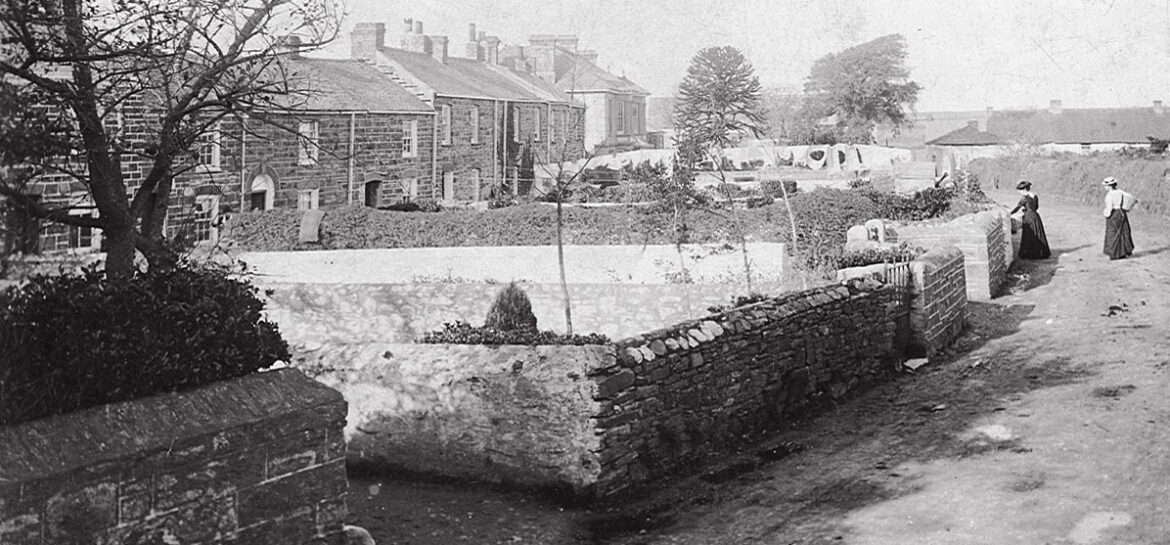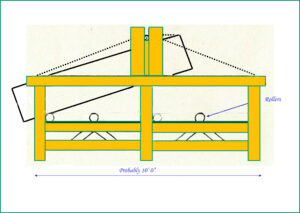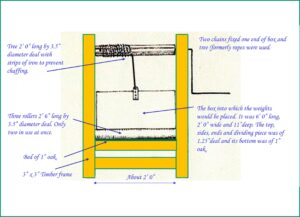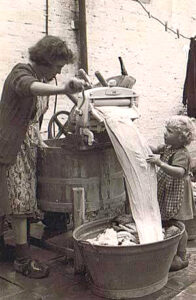
Mangle Houses were once a common feature of most towns and villages where customers could have their laundry pressed for a penny or two. Tony Mansell brings us their story and of the equipment used in them, its construction and usage.
A mangle keeper or mangle woman was someone who offered a laundry pressing service to the people of her community. The possession of a mangle, located in what became known as a mangle house, was a way of earning a living.
It was common to find one or more of these houses in a village and our lead photograph shows one in the typical mining village of Mount Hawke. It was located in the row of cottages to the top right of the photograph, on the site which later became the Village Stores. Chris Chynoweth of Mount Hawke provided this photograph which is titled: “Mrs Whitford and another lady on their way to the mangle house in Mount Hawke”.
The apparatus used to smoothen laundered clothes would have taken many forms but here we are going to consider the box or bed mangle: a common type of equipment which had been in use since the 17th century. It was an ingenious piece designed and developed to replace the hand-held mangle boards. They were often located in very large households, commercial laundries or in mangle houses operated by self-employed mangle women. According to the Mount Hawke Women’s Institute scrapbook, these old-fashioned mangles were about ten feet long with rollers weighed down by stones or sand. Because of their size, they would have been located in the largest room in the cottage or possibly in especially adapted premises. There were many designs, all aimed at lightening the work of the laundry workers. Having said that, more than a little effort was needed to operate them. Because of their simplicity, it is probable that many were made by the village carpenter who, no doubt, used his ingenuity to create a bespoke version to suit his customer’s needs.
Those families who could afford the penny or so, took their washing to the mangle house following which they could proudly exhibit their expertly pressed tablecloths, bed sheets and clothes.
The proprietor may well have offered other laundry services but the prime purpose of the mangle house was to press clothes and other large linen items.
This quote from the Engineer’s and Mechanic’s Encyclopaedia, London of 1838 describes its use. “MANGLE. A domestic machine of great utility, employed in smoothening linen, as a substitute for the heated irons extensively used for the same purpose. In the common mangle, as most of our readers well know, the linen or other articles to be mangled, are wrapped round wooden rollers, which are upon a solid level bed or floor, and upon the rollers is placed a large oblong box which is filled with stones, or other heavy substances, in order that they may press with great force upon the rollers, while the box is moved backwards and forwards upon them, by means of a handle attached to an upper roller or windlass, to which straps from each end of the moving box are attached. By this machine, the operation of mangling is very well done, but the labour is excessive on account of the necessity of frequently arresting and changing the motion of the heavy box.”
A second person was required to prepare the third roller to replace one of the two in use.
An alternative to wrapping the item around the rollers was to lay it on the flat bed on which the box, via the rollers, would exert the necessary pressure. To keep the garment clean, it was covered with a mangle cloth.

 These drawings are based on the description and sketches by J Pearce, the Recorder for Pendeen Old Cornwall Society. Prior to this design, the box would have been moved manually.
These drawings are based on the description and sketches by J Pearce, the Recorder for Pendeen Old Cornwall Society. Prior to this design, the box would have been moved manually.
By the 1820s upright versions were also in use. These had the benefit of requiring considerably less floor space than the box mangle. By then, too, the machines combined the process of wringing out the water and smoothing the items.
The Mangle House has now passed into history, its use rendered obsolete by the commercial steam laundry and by the household mangle and then by our modern, electric versions.
 The domestic mangle which helped to remove the heavy work from Blue Monday or Laundry Blues Day.
The domestic mangle which helped to remove the heavy work from Blue Monday or Laundry Blues Day.

Tony Mansell is the author of several books on aspects of Cornish history. In 2011 he was made a Bardh Kernow (Cornish Bard) for his writing and research, taking the name of Skrifer Istori. He has a wide interest in Cornish history and is a researcher with the Cornish National Music Archive and a sub-editor with Cornish Story – an Institute of Cornish Studies initiative.

Many thanks Tony for this fascinating piece on Mangle Houses. Gosh here I am in my eighty first year and I had never heard of a Mangle House. One goes on learning something new until one’s dead!
Enjoyed Tony!!
Does anything escape Tony’s search for life as was in times gone by ? Such an insignificant invention that eased a housewife’s hard labour, was modified and incorporated into the electric washing machine that many modern housewives used at home in the 50’s and 60’s. How many caught their fingers in the roller ?
Great scriffing Tony. Thank you. John.